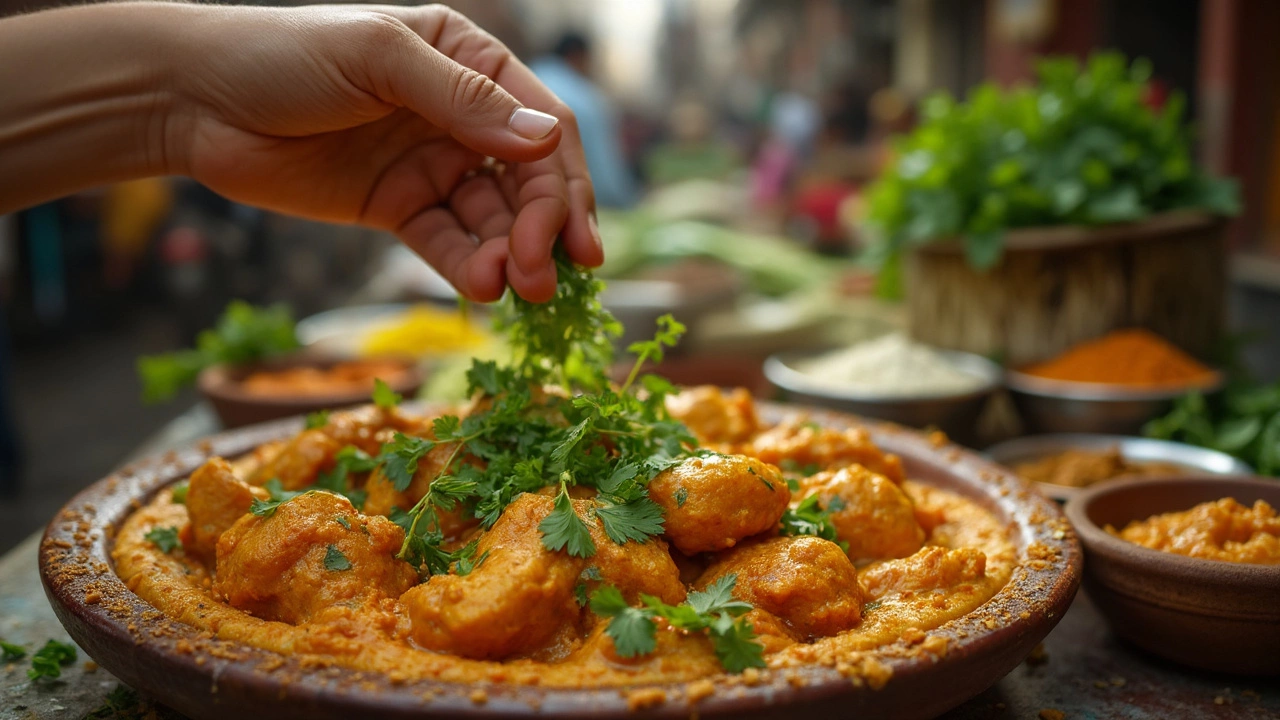18 Mar 2025
- 0 Comments
Who doesn't love a comforting bowl of chicken curry? But sometimes, it needs just a little something extra to really make it sing. The good news is there are plenty of simple, effective ways to enhance your curry's flavor. Your spice cabinet is a treasure trove: cumin, coriander, and turmeric are staples, but a pinch of cinnamon or cardamom can add unexpected depth. And don't underestimate the power of fresh herbs like cilantro or basil for that fresh punch.
Dairy items like yogurt or coconut milk not only cream up the texture but also balance out the heat. If you're feeling adventurous, a spoonful of honey or a splash of lime juice can add a sweet and tangy contrast. Nuts like almonds or cashews can introduce a crunchy layer, while a drizzle of lemon juice might be the hit of acidity you need to tie everything together. It's all about experimenting and finding what tickles your taste buds just right!
- Essential Spices for Flavor
- Adding Fresh Herbs
- Incorporating Dairy
- Sweet and Tangy Touches
- Using Nuts for Texture
- Balancing with Acidity
Essential Spices for Flavor
Spices are the heart and soul of any chicken curry. They have the magical power to transform plain chicken into something delightfully rich and fragrant. So let's look at some promising spices and how they can enhance your curry game.
Cumin
Known for its earthy and slightly peppery flavor, cumin is a must-have. Whether used whole or ground, it adds a warm, aromatic depth that complements the rich undertones of chicken curry. Toast cumin seeds briefly in a pan to release their essential oils for even greater impact.
Coriander
Coriander gives off a fresh, almost citrusy flavor, making it a great counterbalance to the richer spices. It's typically used in conjunction with cumin to strike that harmonious balance that you're aiming for in a curry.
Turmeric
No chicken curry is complete without turmeric. Its subtle flavor isn't overwhelming, but its vibrant color and health benefits make it indispensable. It infuses that golden hue synonymous with a good curry, and it’s known for anti-inflammatory properties, adding more than just taste to your dish.
Garam Masala
Consider garam masala as your finishing spice. This blend of cinnamon, cloves, and black pepper is often added toward the end of cooking to maintain its potent aroma. It elevates your chicken curry with a rich, spicy kick.
Cardamom
Adding just a couple of pods can bring a note of sweet elegance to your curry. Cardamom's fragrant and slightly sweet flavor adds complexity and a unique aroma that plays well with stronger spices.
Spice Pro Tips
- Store spices in a cool, dark place to maintain their freshness and potency.
- Invest in whole spices when possible, and grind them fresh to unlock their full flavors.
- Carefully toast your spices to unleash their essential oils for a bolder taste profile.
Elevation is all about combinations and timings. Experiment a bit, and you'll soon find the mix that resonates with your taste buds and earns rave reviews at the dinner table!
Adding Fresh Herbs
Let's talk about adding fresh herbs to your chicken curry. They might be the secret ingredient you're missing. Herbs not only add color but also bring out vibrant flavors that can elevate your dish to a whole new level.
Cilantro Magic
Cilantro is the go-to herb for many curry lovers. Just a handful can introduce a refreshing zest and slightly lemony flavor that'll make your curry taste bright and lively. Pro tip: sprinkle some chopped cilantro as a garnish right before serving for the best aroma.
Basil's Aromatic Twist
Basil isn’t just for Italian food. Adding Thai or sweet basil can give your chicken curry a unique twist, with its peppery kick and aromatic qualities. Try tearing the leaves to release the oils just before adding it to the pot for an intense burst of flavor.
Mint for a Fresh Kick
If you want something different, fresh mint can bring a refreshing contrast to the richness of a curry. Just like you might use cilantro, mint should be added right at the end to avoid it turning bitter.
Combination Tips
Don't shy away from mixing different herbs—cilantro and mint pair well together and can provide a complex flavor profile. Here’s a quick list of ideas:
- Mix cilantro and mint for a fresh, tangy touch.
- Cilantro and basil for a mix of citrus and spice.
- Mint and basil when aiming for an aromatic play.
Remember, fresh herbs are delicate, so avoid cooking them too long to keep their flavors alive. Your curry is ready to be the star of the show with these simple, fresh additions!
Incorporating Dairy
Adding dairy is one of the surest ways to enrich your chicken curry with a deeply satisfying creaminess. Ingredients like yogurt, cream, or coconut milk can transform your dish into something restaurant-worthy without much fuss. Each type of dairy brings a unique texture and taste to the table, so let's explore how you can use them effectively.
Using Yogurt
Yogurt is a superstar in curry enhancements. It not only adds a velvety texture but also helps to tenderize the chicken. To avoid curdling, make sure to temper it by mixing a bit of the hot curry sauce into your yogurt before adding it back into the pot. This little trick keeps the texture smooth. Greek yogurt works best because of its thickness, so keep a tub handy in your fridge for quick curry fixes.
Coconut Milk for a Tropical Twist
If you're curious about giving your curry a tropical flair, coconut milk is your go-to. It offers a subtle sweetness and richness that pairs perfectly with the spicy notes of your curry spices. When using coconut milk, consider reducing the quantity of strong spices like cinnamon or cardamom to let the coconut's creamy essence shine through.
Heavy Cream for Instant Richness
Heavy cream can instantly elevate your curry’s luxuriousness. Just a splash before serving can thicken the sauce while giving it an indulgent mouthfeel. If you're watching your calorie intake, substitute it with half-and-half and still achieve a creamy outcome.
- Tip 1: Always add the dairy towards the end of cooking to prevent separation.
- Tip 2: For those who are lactose intolerant, lactose-free products work wonderfully without compromising on taste.
Each type of dairy offers its charm, so it’s about figuring out what pairs best with your desired flavor profile. Trying different combinations can lead you to find that perfect balance for your next great chicken curry recipe.

Sweet and Tangy Touches
If you want to give your chicken curry a unique twist, infusing it with sweet and tangy flavors can be a game-changer. It’s like giving your curry a burst of personality! Let’s dive into some tasty ideas to elevate your dish.
Add a Hint of Sweetness
A little sweetness can calm down the spices and add a delightful contrast. Try adding a spoonful of honey or maple syrup. If you prefer something more natural, chop up some apples or pears and let them simmer in the pot. Another option is raisins, especially golden ones—they plump up nicely and provide a delightful surprise with every bite.
Introduce a Tangy Zing
Tanginess is the opposite side of sweetness and brings balance. Squeeze some fresh lime or lemon juice just before serving. It livens up the dish and adds a refreshing kick. Another way is to toss in diced tomatoes or tomatillos; they have natural acidity that blends well with the richness of the curry.
Combine for a Perfect Balance
The magic often happens when sweet and tangy are combined. Consider adding pineapple chunks—yes, it sounds bold, but let them cook till they’ve soaked in some curry goodness. You get juicy bites with a sweet-tangy punch.
These additions can turn your basic curry into something extraordinary and encourage a blend of flavors that'll keep everyone guessing and coming back for more. Don’t be afraid to play around and discover the balance that suits your taste buds the best.
Using Nuts for Texture
Adding nuts to your chicken curry isn't just about flavor; it's also a simple way to up your game's texture. Be it classic almonds or cashews, nuts bring a delightful crunch that complements the softness of the chicken and sauce. Plus, they add a bit of healthy fat, making your curry more satisfying.
But why stop at almonds and cashews? Walnuts, peanuts, or even pistachios can work wonders in your curry, depending on the taste you're going for. A study by the Journal of Culinary Science & Technology highlighted that, "Nuts are a versatile ingredient in enhancing the texture and nutritional profile of a dish."
Nuts are not only rich in essential oils but also balance the spices in your curry, bringing out a subtle sweetness and nuttiness that is simply irresistible.” – Dr. Amit Sharma, Food Scientist
How to Add Nuts to Your Curry
- Toast the nuts in a pan without oil just until they start to turn golden brown. This step intensifies their flavor.
- Choose to either grind the nuts into a fine paste for a creamier texture or keep them whole for a crunchier bite.
- Stir the nuts into the curry towards the end of cooking to keep them crunchy but infused with the sauce's richness.
A sprinkle of nuts can even be used as a garnish, adding an extra layer of texture and appeal. Experimenting with your favorite nut can yield surprising results that might just become your curry's signature twist!
Balancing with Acidity
When it comes to making a delicious chicken curry, balancing flavors is key, and acidity often plays an underrated role. Adding the right amount of acidity can elevate your dish from tasteless to mouth-watering in no time.
Why Acidity Matters
Acidity can brighten up flavors, cut through the richness, and harmonize all the elements in your curry. Think of it as a spotlight that highlights all the good stuff happening in the pot. Many chefs use it as a secret weapon to enhance taste.
Simple Acidic Ingredients
- Lemon or Lime Juice: A dash can instantly lift the flavors. Add it near the end of cooking to keep the citrusy punch intact.
- Tomatoes: Either fresh or canned, they blend well, adding a subtle tang and slight sweetness.
- Vinegar: A small splash of apple cider vinegar or white vinegar can add a sharper acid kick. Use sparingly to avoid overpowering your dish.
When to Add Acidity
Timing is everything. Ideally, you want to introduce acidic elements at the end of the cooking process so they don't mellow out too much. This way, you can taste and adjust accordingly.
Experiment with Ratios
| Ingredient | Amount per Serving |
|---|---|
| Lemon or Lime Juice | 1 tbsp |
| Tomatoes | 1 medium or 1/2 cup canned |
| Vinegar | 1 tsp |
It might take a few tries to get your curry just right, but it's worth the effort. By gradually incorporating acid, you'll notice an improved depth and brightness in your dish. And trust me, your taste buds will thank you!
